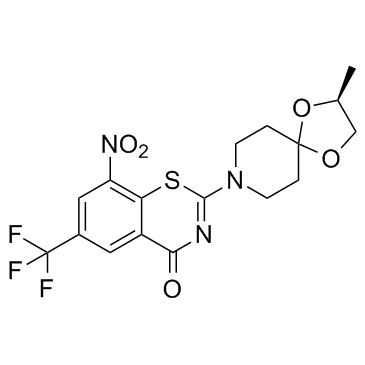BTZ043

BTZ043 structure
|
Common Name | BTZ043 | ||
|---|---|---|---|---|
| CAS Number | 1161233-85-7 | Molecular Weight | 431.386 | |
| Density | 1.7±0.1 g/cm3 | Boiling Point | 547.6±60.0 °C at 760 mmHg | |
| Molecular Formula | C17H16F3N3O5S | Melting Point | N/A | |
| MSDS | N/A | Flash Point | 285.0±32.9 °C | |
Use of BTZ043BTZ043 is an inhibitor of decaprenyl-phosphoribose-epimerase (DprE1), with MICs of of 2.3 nM and 9.2 nM for M. tuberculosis H37Rv and Mycobacterium smegmatis, respectively. |
| Name | 2-[(3S)-3-methyl-1,4-dioxa-8-azaspiro[4.5]decan-8-yl]-8-nitro-6-(trifluoromethyl)-1,3-benzothiazin-4-one |
|---|---|
| Synonym | More Synonyms |
| Description | BTZ043 is an inhibitor of decaprenyl-phosphoribose-epimerase (DprE1), with MICs of of 2.3 nM and 9.2 nM for M. tuberculosis H37Rv and Mycobacterium smegmatis, respectively. |
|---|---|
| Related Catalog | |
| Target |
DprE1[1]. |
| In Vitro | The MIC of BTZ043 against M. tuberculosis H37Rv and Mycobacterium smegmatis are 1 ng/mL (2.3 nM) and 4 ng/mL (9.2 nM), respectively[2]. The in vitro activity of BTZ043 against 30 Nocardia brasiliensis isolates is also tested. The MIC50 and MIC90 values for BTZ043 are 0.125 and 0.25 μg/mL. The MIC for N. carnea ATCC 6847 is 0.003μg/mL, for N. transvalensis ATCC 6865 is 0.003μg/mL, for N. brasiliensis NCTC10300 is 0.03 μg/mL, and for N. brasiliensis HUJEG-1 is 0.125μg/mL. The MIC value for M. tuberculosis H37Rv is 0.000976 μg/mL. The MIC value of BTZ-043 is >64 μg/mL for Escherichia coli ATCC 25922 and S. aureus ATCC 29213[3]. |
| In Vivo | Four weeks of treatment with BTZ043 reduces the bacterial burden in the lungs and spleens by 1 and 2 logs, respectively, at the concentrations used. Additional results suggest that BTZ043 efficacy is time-rather than dose-dependent. Acute (5 g/kg) and chronic (25 and 250 mg/kg) toxicology studies in uninfected mice show that, even at the highest dose tested, there are no adverse anatomical, behavioral, or physiological effects after one month[2]. |
| Animal Admin | Mice[2] Animal efficacy is determined in a standard mouse infection model. BALB/c mice are infected with a low bacillary load (~200 CFU) of M. tuberculosis H37Rv via aerosol. Treatment started four-weeks post infection. Mice are dosed by gavage with 37.5, or 300 mg of BTZ043, per kg body weight, in carboxymethyl cellulose formulation (0.25%), once daily, six times/week, for four weeks. Control and treated mice are sacrificed, lungs and spleens homogenized and dilutions plated for enumeration of viable bacilli[2]. |
| References |
| Density | 1.7±0.1 g/cm3 |
|---|---|
| Boiling Point | 547.6±60.0 °C at 760 mmHg |
| Molecular Formula | C17H16F3N3O5S |
| Molecular Weight | 431.386 |
| Flash Point | 285.0±32.9 °C |
| Exact Mass | 431.076263 |
| PSA | 125.72000 |
| LogP | 2.00 |
| Vapour Pressure | 0.0±1.5 mmHg at 25°C |
| Index of Refraction | 1.666 |
| Storage condition | 2-8℃ |
|
~78% 
BTZ043 CAS#:1161233-85-7 |
| Literature: Makarov Vadim A. Patent: EP2380886 A1, 2011 ; Location in patent: Page/Page column 8 ; |
|
~% 
BTZ043 CAS#:1161233-85-7 |
| Literature: Karoli, Tomislav; Becker, Bernd; Zuegg, Johannes; Moellmann, Ute; Ramu, Soumya; Huang, Johnny X.; Cooper, Matthew A. Journal of Medicinal Chemistry, 2012 , vol. 55, # 17 p. 7940 - 7944 |
| Precursor 1 | |
|---|---|
| DownStream 0 | |
| 4H-1,3-Benzothiazin-4-one, 2-(2-methyl-1,4-dioxa-8-azaspiro[4.5]dec-8-yl)-8-nitro-6-(trifluoromethyl)- |
| BTZ-043 |
| S1097_Selleck |
| 2-(2-Methyl-1,4-dioxa-8-azaspiro[4.5]dec-8-yl)-8-nitro-6-(trifluoromethyl)-4H-1,3-benzothiazin-4-one |
| UNII-G55ZH52P57 |
| BTZ043 |
![(S)-2-methyl-1,4-dioxa-8-azaspiro[4.5]decane structure](https://image.chemsrc.com/caspic/271/1344087-80-4.png)
![2-(methylthio)-8-nitro-6-(trifluoromethyl)-4H-benzo[e][1,3]thiazin-4-one structure](https://image.chemsrc.com/caspic/364/1344087-73-5.png)